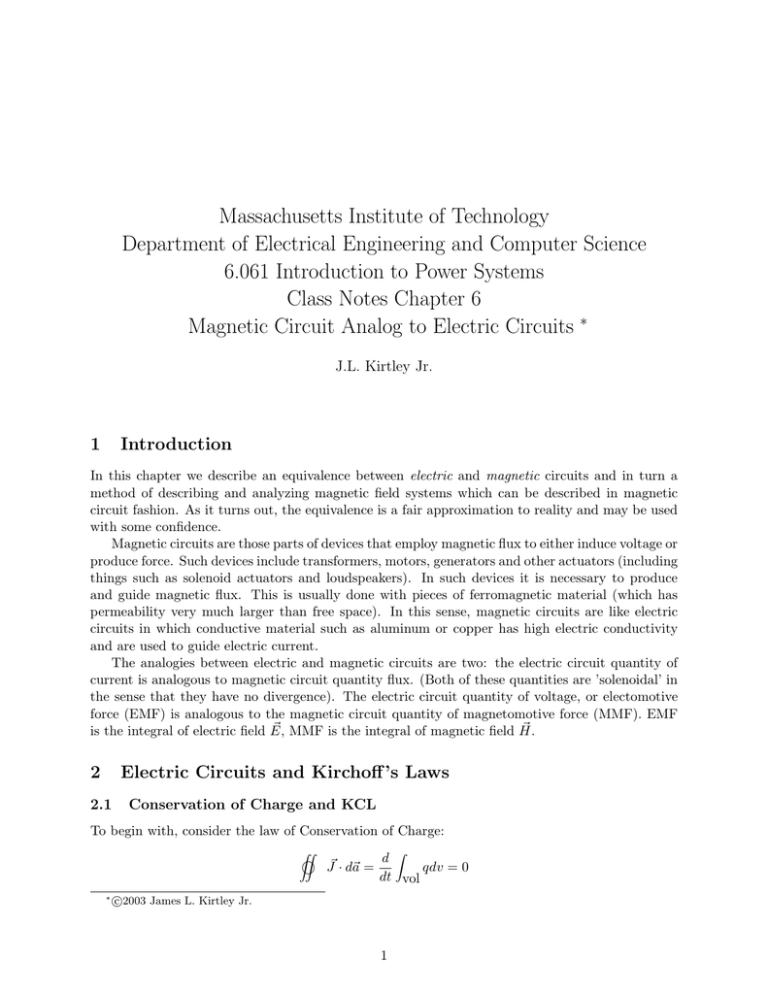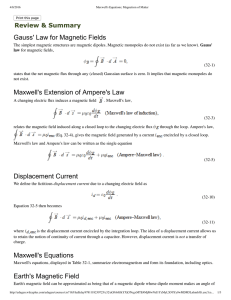Document 13342525
advertisement

Massachusetts Institute of Technology Department of Electrical Engineering and Computer Science 6.061 Introduction to Power Systems Class Notes Chapter 6 Magnetic Circuit Analog to Electric Circuits ∗ J.L. Kirtley Jr. 1 Introduction In this chapter we describe an equivalence between electric and magnetic circuits and in turn a method of describing and analyzing magnetic field systems which can be described in magnetic circuit fashion. As it turns out, the equivalence is a fair approximation to reality and may be used with some confidence. Magnetic circuits are those parts of devices that employ magnetic flux to either induce voltage or produce force. Such devices include transformers, motors, generators and other actuators (including things such as solenoid actuators and loudspeakers). In such devices it is necessary to produce and guide magnetic flux. This is usually done with pieces of ferromagnetic material (which has permeability very much larger than free space). In this sense, magnetic circuits are like electric circuits in which conductive material such as aluminum or copper has high electric conductivity and are used to guide electric current. The analogies between electric and magnetic circuits are two: the electric circuit quantity of current is analogous to magnetic circuit quantity flux. (Both of these quantities are ’solenoidal’ in the sense that they have no divergence). The electric circuit quantity of voltage, or electomotive force (EMF) is analogous to the magnetic circuit quantity of magnetomotive force (MMF). EMF � , MMF is the integral of magnetic field H �. is the integral of electric field E 2 Electric Circuits and Kirchoff ’s Laws 2.1 Conservation of Charge and KCL To begin with, consider the law of Conservation of Charge: � �� d qdv = 0 � J� · d�a = dt vol ∗ c �2003 James L. Kirtley Jr. 1 This assumes, of course, that there is no accumulation of charge anywhere in the system. This is not a wonderful assumption for any systems with capacitor plates, but if one considers capacitors to be circuit elements so that both plates of a capacitor are part of any given element the right hand side of this expression really is zero. Thsn, if we note current to be the integral of current density: Over some area, a fraction of the whole area around a node: ik = then we have: �� � � · d�a Ak J ik = 0 k 2.2 Faraday’s Law : � � · d�� = − d E dt �� � · d�a B The left-hand integral may be taken to be a number of sub-integrals, each denoted by a discrete fractional integral: vk = � bk � · d� E ak If we assume that there are no substantive flux linkages among the circuit elements: �� � =0 B then we have KVL: � vk = 0 k 2.3 Ohm’s Law At this point it is probably appropriate to note that Ohm’s Law can be used to derive the consti­ tutive relationship for a resistor. Suppose we have a conductive element similar to the rectangular solid shown in Figure 1. Assume current is confined in this element and flowing perpendicular to the flat end shown in the figure. Current density is Jx = I hw where I is to total current and h and w are height and width of the conductor, respectively. Electric field along the length of the element is: Ex = 2 Jx σ where σ is the electrical conductivity of the material. Voltage developed is: vk = � Ex d� = Jx l σ Which leads us to an expression for element resistance: R= v l = I hwσ x − V h + l w I Figure 1: Simple circuit element 3 Magnetic Circuits As it turns out, magnetic circuits are very similar and are governed by laws that are not at all different from those of electric circuits, with only one minor difference. 3.1 Conservation of Flux: Gauss’ Law To start, Gauss’ law is: �� � · d�a = 0 � B This reflects that notion that there are no sources of flux: this is a truely sinusoidal quantity. It neither begins nor ends but just goes in circles. If we note a fraction of the surface around a node and call it surface k, the flux through that surface is: Φk = �� � · d�a Ak B If we take the sum of all partial fluxes through a surface surrounding a note we come to the analog of KCL: � Φk = 0 k 3 3.2 MMF: Ampere’s Law Ampere’s Law is simply stated as: � � · d� = H �� J� · d�a The integral of current density J� is current, quantified in the SI system as Amperes. As it is generally carried in wires which might number, say , N , it is often quantified as: �� J� · d�a = N I For this we will often use the term MagnetoMotive Force or MMF, which gets the symbol F . If we use that symbol to denote the integral of magnetic field over a magnetic circuit element: Fk = � bk � · d�� H ak Then, if we take enough of these subintegrals to cover the loop around a group of elements, we have � Fk = N I k Note that this is not exactly the same as KVL, as it has a source term on the right. 3.3 Magnetic Circuit Element: Analogy to Ohm’s Law Magnetic circuits have an equivalent to resistance. It is the ratio of MMF to flux and has the symbol R. I direct comparison with the derivation of resistance, a magnetic circuit element is shown in Figure 2. x − F h + l Φ w Figure 2: Magnetic circuit element Assume that the material of this element has permeability µ > µ0 , so that it has a constitutive relationship: 4 Bx = µHx If flux density in the material is uniform, total flux through the element is: Φ = hwBx = hwµHx And the MMF is simply the integral of magnetic field H from one end to the other: again we assume uniformity so that: F = �Hx The reluctance of this element is then: R= 3.4 � F = Φ hwµ Magnetic Gaps In reality, magnetic circuits tend to be made up of very highly permeable elements (pieces of iron) and relatively small air-gaps. A sketch of such a gap is shown in Figure 3. w µ µ h g Figure 3: Gap between magnetic elements It is usually permissible to assume that iron elements have very high permeability (µ → ∞), so that there is negligible MMF drop. In this sense the iron elements serve in the same role as copper or aluminum wire in electric circuits. The gap, on the other hand, has reluctance: Rg = g hwµ0 5 Ha Bm Bg Hm µ µ Fringing Field Figure 4: Gap details 3.5 Boundary Conditions Shown in Figure 4 is the cross-section of a gap. It is assumed that the elements shown have some depth into the paper which is greater than the gap width g. If the permeability of the elements to the right and the left is very high, we say that magnetic flux is largely confined to those elements. Note that the boundary condition associated with Ampere’s Law dictates that the magnetic field intensity Ha in the air adjacent to the permeable material and parallel with the surface must be equal to the magnetic field intensity Hm just inside the magnetic material and parallel with the surface. If the material is very highly permeable (µ → ∞), that magnetic field must be nearly zero: Ha = Hm → 0. This means that magnetic field must be perpendicular to the surface of very highly permeable material. This is the case in the gap itself, where: Bg = Bm We should note, however, that there will be ’fringing’ fields in the region near the gap, so that our expression for the reluctance of the gap will not be quite correct. The accuracy of the expression which ignores fringing is best for really small gaps and generally over-estimates the reluctance. 4 Faraday’s Law and Inductance Changing magnetic fields give rise to electric fields and consequently produce voltage. This is how inductance works. Consider the situation shown rather abstractly in Figure 5. Faraday’s Law is, in integral form: � � · d� = − d E dt �� � Area B · �nda If the contour shown is highly conducting (say, if it is a wire), there is zero electric field over that part of the contour. Voltage across the terminals is: Vab = � b � · d� E a and that is the whole of the integral above. Thus we may conclude that: 6 dl + n a i V − b Figure 5: Loop for Faraday’s Law Vab d =− dt �� � Area B · �nda Now, if we define flux linked by this contour to be: λ=− �� � Area B · �nda then voltage is, as we expect: Vab = dλ dt As it turns out, current flowing in the wire with sense shown by i in Figure 5 tends to produce flux with sense opposite to the normal vector shown in that figure, and so produces positive flux. Generally, in calculating inductance, one uses the ’right hand rule’ in determing the direction of flux linkage: if the fingers of your right hand follow the direction of the winding, from the positive terminal, positive flux is in the direction of your thumb. 4.1 Example: Solenoid Actuator Shown in Figure 6 is a representation of a common solenoid actuator. When current is put through the coil a magnetic flux appears in the gaps and pulls the plunger to the left. We will examine the force and how to calculate it in later chapters. For now, however, we are concerned with magnetic fields in the device and with the calculation of inductance. Assume that the stator and plunger are both made of highly permeable materials (µ → ∞). If the coil carries current I in N turns in the sense shown, magnetic flux will cross the narrow air-gap to the right in the direction from the stator to the plunger and then return in the sense shown in the variable length gap of width x. It is clear that this is also positive sense flux for the coil. The magnetic circuit equivalent is shown in Figure 7. All of the flux produced crosses the variable width gap which has reluctance: 7 Depth D perpendicular to view NI Coil Plunger h g B µ Stator w x Figure 6: Cross-Section of Solenoid Actuator Φ x F g g Figure 7: Magnetic Equivalent Circuit of Solenoid Actuator Rx = x µ0 hD Half of the flux crosses each of the other two gaps, which are in parallel and have reluctance: Rg = g µ0 wD Total flux in the magnetic circuit is Φ= F Rx + 21 Rg And since λ = N Φ and F = N I, the inductance of this structure is: L= N2 N2 = R Rx + 21 Rg 8 MIT OpenCourseWare http://ocw.mit.edu 6.061 / 6.690 Introduction to Electric Power Systems Spring 2011 For information about citing these materials or our Terms of Use, visit: http://ocw.mit.edu/terms.



